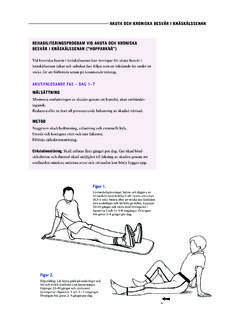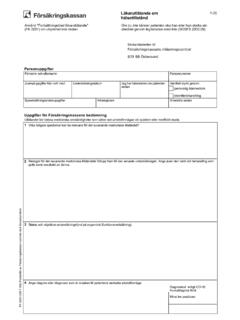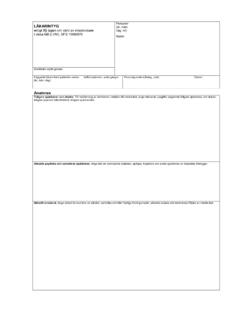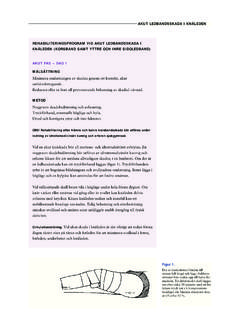Transcription of Hypomania Check List (HCL-32 R1) Manual - …
1 Hypomania Check List (HCL- 32 r1 ) Manual The HCL- 32 r1 is a self-rating questionnaire for lifetime history of hypomanic symptoms. The HCL-32 is in development in many countries and is available in more than 20 languages. To date, most patient data have been collected in Italy, Sweden, Spain, Germany and Taiwan. Background Over a lifetime every human being experiences significant changes in energy, activity and mood, such as lows (sadness, loss, bereavement) and highs (romantic love, personal success and achievement) of shorter (hours, days) or longer (weeks, months) duration. There is a continuum from normal lows and highs to clinically relevant depression/melancholia and Hypomania /mania. In clinical practice, hypomanic symptoms are often not identified because they are either not experienced or not recognized as abnormal by the individual and therefore are not spontaneously reported.
2 As a consequence, many patients diagnosed as unipolar depressives may have an unrecognized bipolar disorder. Identifying these "hidden" bipolar cases is important to ensure proper, effective treatment. What can the HCL- 32 r1 be used for? 1. Self-assessment of lifetime experiences of hypomanic symptoms on the continuum from normal to pathological. 2. Screening for bipolar-II, minor BP and subthreshold Hypomania . The HCL-32-R1 does not provide a diagnosis of bipolar disorder, but can aid identification of potential bipolar cases in psychiatric, psychological and general practice. Who should use the HCL- 32 r1 ? General Practitioners, Psychiatrists, Psychologists. Who should the HCL- 32 r1 be administered to? The HCL- 32 r1 is applicable to normal subjects and out-patients.
3 However, it was mainly developed for screening patients with a diagnosis of depression (Major Depressive Disorder, Dysthymia, Minor Depression, Recurrent Brief Depression) for hypomanic symptoms. Limitations: the instrument seems not to be suitable for illiterate and mentally sub-normal subjects. Up to now data from patients hospitalised for severe mania and melancholia are only available from one center in Taiwan. Version 06-2007 How are the results of the HCL- 32 r1 scored? The total score is the number of positive answers to the 32 items listed in question 3. Individuals with a total score of 14 or more are potentially bipolar and should be carefully interviewed, including previous history and family history; if possible, significant others should be questioned.
4 A thorough examination is also indicated in subjects from the general population with a score of 14 or more who additionally report any negative, or mixed negative and positive, consequences of their experiences ( reactions from others). Caveat: subjects with less than 14 positive answers can still be bipolar cases. The structure of the HCL- 32 r1 Question 1 ("How are you feeling today compared to your usual self?") is used to asses whether the subject's current emotional state has an impact on the answers given to the list of 32 items. In outpatients this has not been found to be the case. Severe mania and depression seem to influence the measurements. Question 2 ("How are you usually compared to other people?)
5 ") is used to assess affective temperaments, whether a subject may be persistently hyperthymic, depressed, or cyclothymic. Question 3 is the core of the instrument and consists of a checklist of 32 symptoms, which require simple yes/no answers. The total number of positive answers ("total score") can be calculated easily. In depressed patients, 14 or more positive answers indicate possible bipolarity. Questions 4 to 7 are of clinical relevance and ask about impact of hypomanic symptoms on everyday life, reactions of significant others, and days spent in highs during the last twelve months. Factor structure. The 32 items of Question 3 load on two factors, which were replicated in patient and general population samples and were labeled "active/elated" and "irritable/risk-taking".
6 The sum of the following items forms the dimension active/elated : 2, 3, 4, 5, 6, 10, 11, 12, 13, 15, 16, 19, 20, 22, 24, and 28; a sum score of 12 or higher may indicate rather an active/elated Hypomania . The sum of the following items forms the dimension "irritable/risk-taking": 7, 8, 9, 21, 25, 26, 27, 31 and 32; a sum score of 3 or higher may indicate rather an irritable/risk-taking Hypomania [cf. Angst et al., 2005; Tables 3 and 4]. Predictive value, sensitivity and specificity In previous studies, the positive and negative predictive power was 73% and 61%, respectively. This means that 73% of patients identified by the HCL- 32 r1 as potential bipolar cases (total score of 14) will be true bipolar cases, whereas 61% of patients identified as non-bipolar cases (total score <14) will in fact be non-bipolar cases.
7 The HCL- 32 r1 had a sensitivity of 80% and a specificity of 51%. The discrimination between bipolar-I and bipolar-II disorder is the target of further research. References Angst J, Adolfsson R, et al. (2005). J Affect Disord 88: 217-233. - Brand S, Luethi M, et al. (in press). J Adolesc Health. - Carta MG, Hardoy MC, et al. (2006). Clinical Practice & Epidemiology in Mental Health 2: 2 - Meyer TD, Hammelstein P, et al. (2007). Compr Psychiatry 48: 79-87. Vieta E, Sanchez-Moreno J, et al. (in press). J Affect Disord. - Wu YS, Ou CS, et al. (in press). J Affect Disord. Version 06-2007








